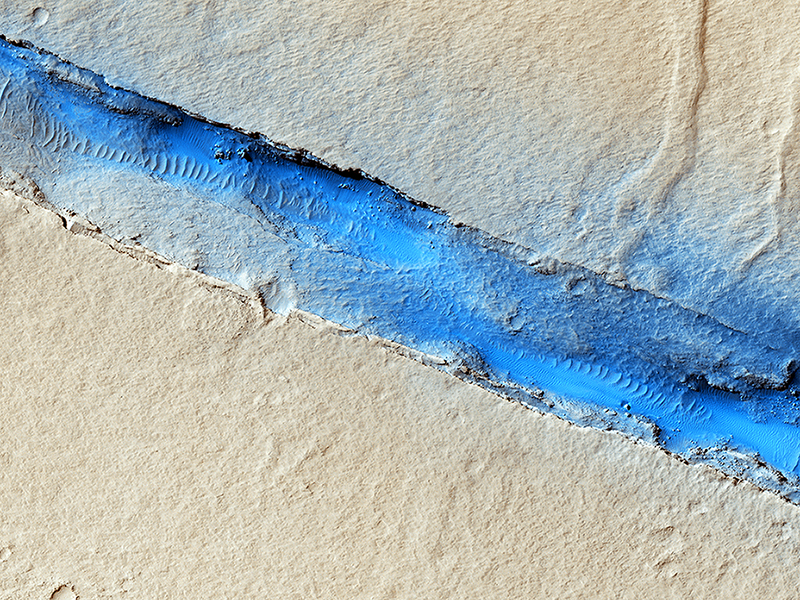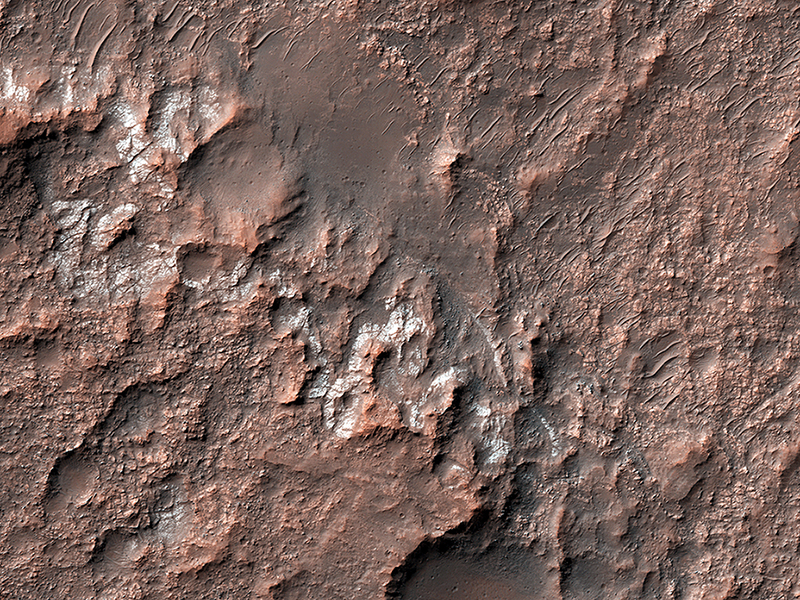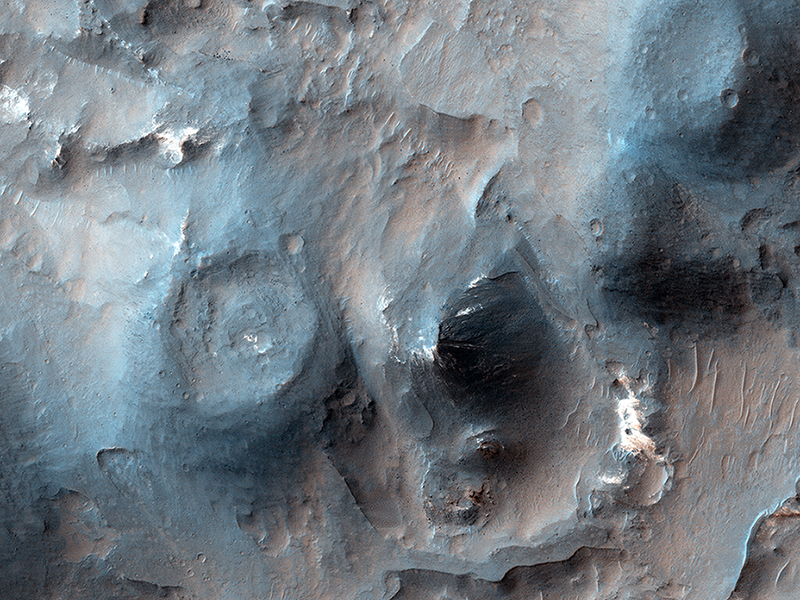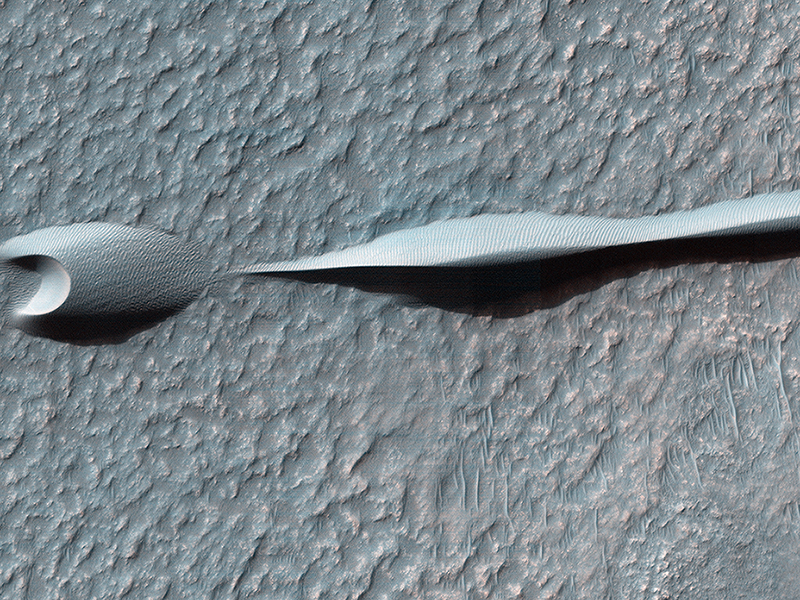HiRISE Science Team wrote:Fissure near Cerberus Fossae with Tectonic Morphologies (ESP_034716_1875) (HiClip)
The linearity of the volcanic vent shown in this HiRISE image, in conjunction with evidence of lava flow from the vent, suggests control by combined volcano-tectonic processes. The details of this vent gained by HiRISE should provide insight into those volcano-tectonic processes along Cerberus Fossae fissures in two ways.
The nature of both the volcanic products along this fissure, and the geometries of the linear vent, will permit comparison with similar, non-volcanic fissures at Cerberus. And results from these comparisons will provide insight into the orientation of the underlying dike system that may have controlled the ascent of water to the surface in the Cerberus region.
Future topographic analysis with a second image in order to create a 3D picture will enable us to measure the heights of the associated flows and better understand their volcanic history.
Ramy El-Maarry wrote:Looking for Salts on Mars (ESP_034309_1485) (HiClip)
Why are scientists interested in areas that contain salts on Mars? Simply put, salts usually form by evaporation of liquid water. Most salts can easily dissolve in water, and if that water evaporates away completely, the salt is left behind as a deposit or residue. The larger the amount of salts initially dissolved, the larger the salt deposit left behind when the water evaporates. So when scientists look for regions on Mars that have noticeable salt deposits, they are effectively looking for areas that may have contained liquid water in the past.
A few years ago, a group of scientists found more than 600 locations on Mars that may contain chloride salts, which could be very similar to common table salt. Since then, scientists have been using the HiRISE camera to look at these locations more closely and they have found out that many of these locations are very similar to dried lakes on Earth, which are sometimes called “playas” or “salt pans.” Many such playas can be visited in California and Arizona such as the Racetrack playa and the Death Valley National Park.
In this image, the chlorides have a bright appearance and are covered by other dark materials. Interestingly, the bright deposits also display cracks that form polygonal patterns very similar to common mud cracks, which may be another indication that these deposits formed when salty waters evaporated away. Studying these regions in detail can help scientists understand when and how the weather conditions on Mars may have changed.
Alfred McEwen wrote:Recent Volcanism in Valles Marineris (ESP_034131_1670) (HiClip)
The possibility of recent volcanism inside Valles Marineris was first proposed decades ago based on Viking orbiter images, but the candidate volcanoes proved to be other features such as complex sand dunes when we studied them with higher-resolution images.
However, this image shows cones with summit pits that are very similar to cinder cones on Earth. They are also very well-preserved, peppered by only small impact craters, so they must be geologically young (perhaps less than a few hundred million years).
These features were first seen in Context Camera image D01_027538_1674_XN_12S062W and a HiRISE target was suggested by a member of that team using HiWish. The cones might look like craters in single images, but if you look at the stereo anaglyph, you’ll see the cones stick up and are clearly not the same shape as impact craters.
This is a stereo pair with ESP_033986_1670.
Chris Okubo wrote:Dunes on the Rim of the Hellas Impact Basin (ESP_034101_1385) (HiClip)
Sand dunes like these seen in this image have been observed to creep slowly across the surface of Mars through the action of the wind. These are a particular type of dune called a “barchan”, which forms when the wind blows in one direction (here, east to west) for long periods of time. Barchan dunes are common on Mars and in the desert regions of the Earth.
These barchan dunes are located on the western rim of the Hellas impact basin, in the Southern Hemisphere of Mars. This area is covered by extensive deposits of layered rocks that were initially deposited as loose sediments and over time formed these rock layers. Portions of these layered rocks were subsequently eroded away and the remaining layers now form numerous flat-topped hills called “mesas”. The barchan dunes are forming in the lee (or downwind) of the mesas.
This area was previously image by HiRISE in 2008 and was retargeted here through a public request via HiWish. Careful comparison of repeat images such as these can reveal the speed and manner by which dunes move across the Martian surface. This information can be used to study the current atmosphere of Mars, the age and mobility of sand deposits on the planet’s surface, and the hazards that sand dunes may pose to landed vehicles such as rovers.
Over the course of its mission, the science instruments on board the Mars Reconnaissance Orbiter (MRO) have returned over 200 terabits of data back to Earth. This image was taken on November 4, 2013, the same day that MRO’s 200-terabit mark was surpassed.
Credit: NASA/JPL/University of Arizona
<< Previous HiRISE Update



